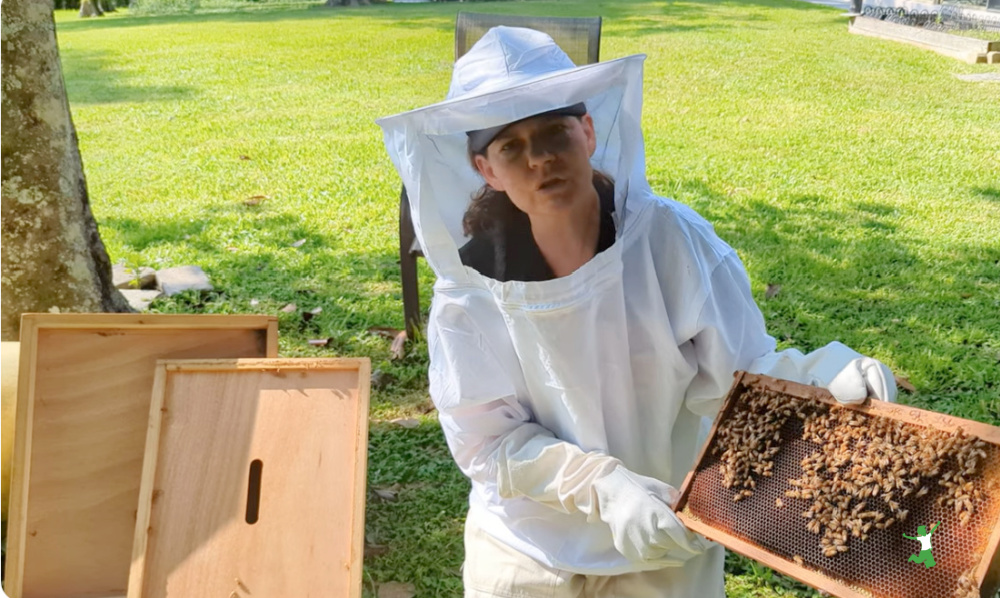Table of Contents[Hide][Show]
How to use the nonlethal “sugar shake” method to check a backyard residential beehive for a varroa mite infestation.

Varroa mites are one of the biggest threats to the health and long-term viability of a beehive.
For those of us who keep honeybees in the backyard, it is important to do routine monthly checks for varroa to ensure that all is well with your winged friends!
“Sugar Shake” Test for Varroa Mites
In this latest video added to my playlist on beekeeping, I use what is called the “sugar shake” method for a varroa mites check.
This method is taught by the Institute of Food and Agricultural Sciences at the University of Florida. (1)
The sugar shake is a nonlethal, nonharmful method to safely check your hive for a varroa mite infestation.
It involves four steps:
- Collect a half cup of bees from a brood frame (make sure the queen is not on this frame first).
- Coat the test bees with 2 tablespoons of powdered cane sugar and let them sit for 5 minutes.
- Gently shake the sugar onto a white surface and count the number of dislodged mites. Three or fewer mites is considered a “pass”.
- Optional step: Lightly spritz the sugar on the testing surface with water using a spray bottle. This partially dissolves the sugar into the white paper towel lining the pan (what I use as a testing surface). This makes the mites more visible and easier to count.
- Safely return the test bees to the hive. Their friends will clean them up in a hurry!
Pros
The primary benefit of the sugar shake is that it is a quick and easy method for novice and amateur beekeepers to keep tabs on the health of the hive.
Another big plus is that the test is harmless and nonlethal to the test bees.
Cons
The only drawback of the sugar shake method is that it is less accurate in humid weather.
This is because a high moisture content in the air causes the powdered sugar to clump, resulting in a less accurate result.
This downside is easily remedied by performing the test inside an air conditioned building.
Simply capture the test bees in a jar and move inside a climate-controlled room to conduct the remainder of the test.
Failed Test?
If the test for varroa mites fails, then remedial action to control the excessive varroa mites is a good idea.
This video on how to safely treat a backyard beehive for varroa mites provides more details.
Another alternative is to transition to brood frames with smaller hexagonal cells, such as what would be found in wild honeybee colonies. Some research suggests that this can help to short-circuit the varroa mite lifecycle with no harm to the hive. This is a favored approach by beekeepers who espouse a hands-off method for controlling varroa. (2)
There are other options to consider for safe, nonlethal varroa control such as using a screened bottom board (which I use). (3)
Another idea is to make homemade pollen patties for the bees to provide extra nutrition. A strong hive is naturally resistant to any infestation including varroa. This is something I am going to use myself and will be covering in a later post and video! (4)
(1) Institute of Food and Agricultural Sciences at the University of Florida
(2) An Integrated Pest Management Approach to Control Varroa Mites
(3) A Meta-Analysis Shows That Screen Bottom Boards Can Significantly Reduce Varroa destructor Population
(4) How To Prevent And Control Varroa Mites In Your Hive








Hi Sarah, love your posts and content and have for years. I’m a 6 year beekeeper in central Texas and have bad treatment free hives without losing a single one in all these years. I never check for varroa as the bees are quite capable of finding them and getting rid of them on their own. Varroa never take out a colony; a weak colony becomes overcome by opportunistic varroa. I really like the work of Les Crowder and Michael Bush. Top bar hives allow bees to grow their own comb in the natural shape like in the wild, no crushing of bees kn inspection, no lifting heavy boxes, better air flow and less warmth loss in winter. Just sharing what I’ve learned and my bees are thriving, healthy, resilient and the honey and comb is clean.
Thank you for this wonderful information! I am learning all I can. It is the most fascinating hobby I’ve ever had!